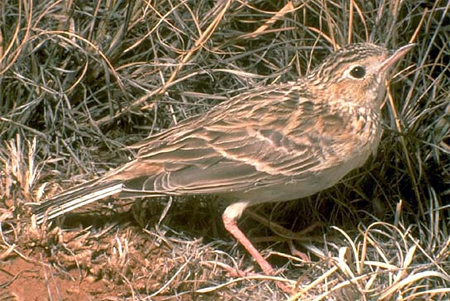
Sprague's Pipit
Credit: R. K. Bowers
So when a bird is recognized as an endangered species, it automatically becomes protected by the federal government, right?
Not necessarily.
The U.S. Fish and Wildlife Service (USFWS) issued a ruling earlier this month that there was sufficient evidence to conclude that the Sprague’s Pipit warrants protection under the Endangered Species Act (ESA). Sprague’s Pipit is a rapidly declining grassland bird that breeds in the prairie and grasslands regions of Canada and the United States and winters in the southern U.S. and Mexico. Unfortunately the USFWS also announced that the agency does not have enough resources to actually allow the species to be added to the list of Threatened and Endangered species protected under the ESA. That means that the species is now instead added to the growing list of what are called Candidate species—species that should be listed as Endangered or Threatened and receive additional protection but will not. The Sprague’s Pipit is threatened but it will receive no additional protection beyond its current protections under the Migratory Bird Treaty Act. The recent USFWS action came after years of requests by environmental groups, including a 2008 lawsuit. Sprague’s Pipit has also been listed as Threatened under Canada’s Species At Risk Act since 2003 and a recovery plan was published in 2008. The Canadian recovery plan has the following goal:
“The recovery goals for the Sprague’s Pipit are to increase and then maintain population size and distribution at or above the 1980–1989 levels throughout the pipit’s historic range in Canada and to prevent further loss and degradation of native prairie within its historic range.”
Unfortunately it appears that except for some limited research, no major efforts have been undertaken to reach these recovery goals.
The migratory Sprague’s Pipit relies on intact wild prairies and grasslands for nesting and rearing its young. The massive conversion of these habitats to agriculture in the late 1800s and early 1900s significantly reduced its range, and subsequently its population. Over the past 40 years its population has been reduced by 80%, meaning formal protection of remaining blocks of intact habitat and restoration of degraded habitat is vital for its long-term wellbeing.

Range of the Sprague's Pipit
Borrowed from the sdakotabirds.com website
I have a chapter devoted to the Sprague’s Pipit in my book Birder’s Conservation Handbook: 100 North American Birds at Risk, where you can find a more in-depth description of its behavior, range, threats, and conservation opportunities:
View chapter online >
The story of the Sprague’s Pipit’s official government status and its protection was also chronicled in the Montreal Gazette last week:
Go to story >
Many people are surprised to find out how many truly endangered and threatened species are not listed under the U.S. Endangered Species Act. This story I wrote for Birder’s World magazine goes into more details about the issue, as do several of these academic publications:
Global versus local conservation focus of U.S. state agency endangered bird species lists:
http://www.plosone.org/article/info%3Adoi%2F10.1371%2Fjournal.pone.0008608
A comparison of North American avian conservation priority ranking systems:
http://www.ese.u-psud.fr/epc/conservation/PDFs/ECOE/mehlman.pdf
Some worry that having an Endangered Species Act list that does not include all endangered species delegitimizes the ESA and its official list. Probably that’s true to some extent. But on the other hand the ESA is a policy tool - not a scientific process - and its scientific accuracy will always be imperfect and based on prevailing public opinion and politics. Species that should be listed will be more likely to be listed when those of us in the public make it clear that we feel that maintaining the ecological bank account upon which all economies depend is a high priority. To keep that ecological bank account healthy and growing requires us to pay attention to species that are signaling a problem, as is the 80% decline in Sprague’s Pipit. Clearly the U.S. Fish and Wildlife Service is not receiving the resources it needs to do its part in implementing a policy that was signed into law (the Endangered Species Act) in 1973 when the U.S. public said, in essence, that maintaining the ecological bank account was a national priority. While economic indicators rise and fall and stocks go up and down, species that go extinct will never be given a second chance.

